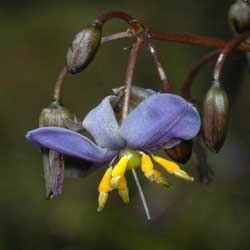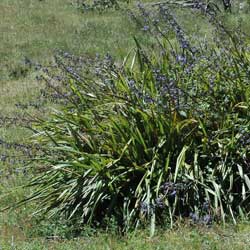Dianella tasmanica
Blue Flax Lily, Tasman Flax lily
The first specimen of Dianella tasmanica was collected in 1837 by Ronald Gunn in Tasmania. It is a perennial species found in moist, shaded forests in Tasmania, Victoria and along the east coast of New South Wales. Its common names include Tasman Flax Lily, Flax Lily and Blue Berry Flax Lily.
 The strap-like leaves are up to 950 mm long and between 14 to 32mm wide, indented along the mid vein, with a toothed edge that has a tendency to curl backwards on some leaves. There is a red edge on most leaves near the base of the flattened clumps. On branching stems the small clusters of lavender to violet flowers, with yellow stamens and anthers, are produced in spring to summer, followed by large blue berries 10 to 25 mm long. The fruits are bird dispersed. Aboriginal people have used the fruit to dye Lomandra leaves when making baskets.
The strap-like leaves are up to 950 mm long and between 14 to 32mm wide, indented along the mid vein, with a toothed edge that has a tendency to curl backwards on some leaves. There is a red edge on most leaves near the base of the flattened clumps. On branching stems the small clusters of lavender to violet flowers, with yellow stamens and anthers, are produced in spring to summer, followed by large blue berries 10 to 25 mm long. The fruits are bird dispersed. Aboriginal people have used the fruit to dye Lomandra leaves when making baskets.
Propagation can be by seed, but is best carried out by clump division.
A number of cultivars exist of this species. ‘Little Devil’ is a more compact variety and ‘Rainbow’ has a variegated leaf. ‘Tasred’, which has more red tones especially in the cooler climates in the cooler months, is also known to be tolerant to salt spray such as from the ocean, a salty bore or grey water with a high salt content.
Once established, Dianella tasmanica needs little or no work or irrigation as it is drought and frost tolerant. It does prefer some shade but can grow in heavy shade. It would be a great choice for mass planting under large trees.
Text by Lesleigh Lougheed Davis (2009 Botanical Intern)
Name Meaning: Dianella tasmanicaDianella – from the Greek Diana – goddess of the hunt and ella – small tasmanica – from Tasmania |
References
Australia’s Virtual Herbarium (AVH) (2009). Council of Heads of Australian Herbaria (CHAH). Available at http://www.cpbr.gov.au/chah/avh/index.html
George, A.S. (Ed.) (1987) Flora of Australia Volume 45, Hydatellaceae to Liliaceae, Australian Government Service, Canberra.
Layt, T. (n.d.) Salt Tolerance Test for Ozbreed plants . Ozbreed Environmental Turf and Plant Breeding. Available at http://www.ozbreed.com.au/research-papers/salt-research.html
Spencer, R. (2005) Horticultural Flora of South-eastern Australia. Volume 5: flowering plants. Monocotyledons. University of New South Wales Press, Sydney.
Taylor , D. (2009) Australian National Botanical Gardens. Personal communication.
Wilson, K.L. (1993). Dianella tasmanica Hook.f. in PlantNET - The Plant Information Network System of Botanic Gardens Trust, Sydney, Australia (Version 2.0). Available at http://plantnet.rbgsyd.nsw.gov.au/cgi-bin/NSWfl.pl?page=nswfl&lvl=sp&name=Dianella~tasmanica
![An Australian Government Initiative [logo]](/images/austgovt_brown_90px.gif)




